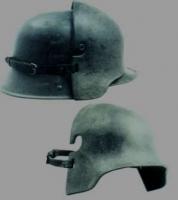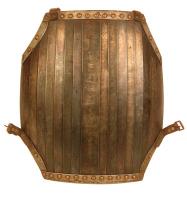
Доспех начала-середины 20го века
#21

Опубликовано 19 Февраль 2009 - 19:00
#22

Опубликовано 19 Февраль 2009 - 19:12
http://www.npo-sm.ru/mag/3055.html
Немецкий комплект из кирасы и шлема с усиленной бронёй либо с бронемаской для лица
#23

Опубликовано 20 Февраль 2009 - 14:26
Есть постановление Кагановича на изготорление трех тысячь штук. так что оно да не оно....
http://pehota.gip-gip.ru/forum-f66
#24

Опубликовано 20 Февраль 2009 - 15:15
Есть мнение, что их выпустили 10 тысяч, только ни каких этому подтверждений не приводят.
После выпуска первой партии СН-38 нагрудник признали не пригодным для использования и отправили на склады Ленинграда, про них снова вспомнили уже когда враг враг стучался в двери.


Фото: Army Ordnance Dept
В первые дни 1918 года артиллерийско-техническое управление Франции проводило испытание старых кирас на полигоне форта де ла Пеньи. Укрытых металлическим панцирем солдат расстреливали из пистолета, винтовки и пулемета со вполне обнадеживающими результатами.
#25

Опубликовано 02 Март 2009 - 14:16
Numéro d'inventaire : 1101839
Dénomnination : Projet de plastron cuirasse (France, 1914-1918)
Numéro d'inventaire : 1101840
Dénomnination : Cuirasse française à lamelles, projet, circa 1917
#26

Опубликовано 13 Март 2009 - 17:53

и история его похождений
The reward for the outlaws was increased to £2000 a head and black trackers were brought from Queensland. Aaron Sherritt, a friend of Joe Byrne’s, became an agent for the police, and on Saturday, 27 June 1880, was shot dead by Byrne in his own doorway near Beechworth, while the four constables assigned to guard Sherritt hid in a bedroom. Byrne and Dan then joined Ned and Hart at Glenrowan, where they took possession of the hotel run by Mrs Ann Jones and detained about sixty people. The outlaws foresaw that a special train would be sent from Melbourne on Sunday night, and would arrive at Glenrowan early on Monday, 29 June, and with the intention of wrecking it they compelled two railway workers to tear up some of the rails. The scheme came to nothing because a schoolmaster, Thomas Curnow, whom Ned had allowed to leave the hotel with his wife, child and sister, gave warning to the train crew. The other outlaws were equipped with armour made from plough mould-boards and Ned was protected by a cylindrical headpiece, breast and back plates and apron weighing about 90 lbs (41 kg). Little sleep and much consumption of alcohol affected their judgement and, although the armour limited their movements and use of firearms, it gave them a false sense of invulnerability. Under Superintendent Hare, the police surrounded the hotel and shooting began. Hare was shot in the arm and Ned wounded in the foot, hand and arm. Dan, Byrne and Hart took refuge in the hotel and Ned went into the bush. The police continued to fire; Byrne was shot in the thigh as he stood at the hotel bar, and bled to death. About 5 a.m. Ned returned, still clad in armour, looking huge and grotesque in the early mist. He was brought down by bullet wounds in the legs.
бывают крепости из-за которых не борются; бывают местности, из-за которых не сражаются;
бывают повеления государя, которые не выполняют.
Позитивная вовлечённость в процесс на основе уважения и конструктивности - отличительная черта коммуникаций внутри организации
#27

Опубликовано 13 Март 2009 - 19:28
Помни о Тынисмяги!
#28

Опубликовано 16 Март 2009 - 11:10
http://borianm.livej....com/51282.html
http://borianm.livej....com/90637.html
Вот ссылочки хорошие , правда большинство артефактов уже тут выложенно..
Изменено: likantrop, 16 Март 2009 - 12:38
#29

Опубликовано 21 Март 2009 - 13:36

#30

Опубликовано 27 Апрель 2009 - 16:54

On some Armour presented to Titore, a Nga Puhi Chief, by H.M. William IV in 1835.
By A. Hamilton.
[Read before the Wellington Philosophical Society, 6th October, 1909.]
Dr. Maui Pomare deposited in the Dominion Museum in November, 1908, some pieces of “armour” which was supposed to be the armour belonging to the great Nga Puhi chief Hongi.
Dr. Pomare stated that Hongi's armour descended to his relative and fighting chief, Tuwhare. About the end of the twenties this chief led an expedition against the Whanganui Tribe, and, in a bloody battle which resulted, his nephew Tokiwhati, with others of the Nga Puhi, was taken prisoner. Tuwhare, who was wounded in the same fight, and died shortly afterwards at Mokau, on his way to the Bay of Islands, learned that Tokiwhati was still alive, and entered into negotiations for his release. Either as a gift or ransom the treasured suit of armour was handed over to Hori Kingi te Anaua, uncle of the late Major Kemp. The armour was placed in the sacred house at Pukehika, opposite Jerusalem, till the walls of that edifice were tumbling down, and Hore Pukehika, a relative of the late Hori Kingi, and the present Native Sanitary Inspector for that district, hearing that some Europeans were planning how to carry off the relics, concealed them very carefully near the pa. This was thirty or forty years ago, and the armour lay undisturbed till a few weeks ago. Then Hori Pukehika and Dr. Pomare sought out the place, and, after laborious searching—for the scrub and other features had changed a great deal in the interval—discovered the old armour, rusty, but quite recognisable.
The armour consisted of plate armour for the back and chest, and pieces for the arms. It is much eaten with rust, but, considering that it is stated that it has been buried, is in fair preservation. It is fastened together with brass studs.
On looking into the details of the story given, and comparing them with the known and recorded facts concerning Hongi's armour, it became apparent that the history of the armour was incomplete, and that there were serious discrepancies.
In the first place, Earl, in 1827, speaking of the visit of Hongi to England in 1821, mentions that George IV gave him, amongst other presents of value, “a superb suit of chain armour and a splendid double-barrelled gun.”* Taylor also speaks of Hongi giving the coat of mail to one of his sons when on his death-bed in 1827.† There are at least two other notices, the earliest of which is in Angas's “Savage Life and Scenes,” 1847;‡ and I must give this in full, as it contains several details which are of interest. Angas writes from Paripari, Mokau, “At a small pah not far from the abode of his pakeha (Lewis), Taonui the chief has his residence. He is one of the most powerful and superstitious of the old heathen chiefs…. He has also in his possession the original suit of armour that was given by King George IV of England to the Bay of Islands chief (E'Hongi), when that warrior visited England. The subsequent history of this armour is somewhat curious: it passed from the Nga Puhi to Titore, and from Titore to Te Whero Whero, at the Waikato feast, and came into Taonui's hands under the following circumstances: On the death of a favourite daughter, To Whero Whero made a song, the substance of which was that he would take off the scalps of all the chiefs except the Ngaweka and fling them into his daughter's grave to revenge her untimely death. The words of the song highly insulted the various individuals against whom it was directed, more especially as it was a great curse for the hair of a chief, which is sacred, to be thus treated with contempt. But the only chief who dared to resent this insult from so great a man as Te Whero Whero was Taonui, a chief of Nga Puhi and Ngati Whatua, who demanded a taua or gift as recompense for the affront, and received the armour of E'Hongi in compensation. I made a drawing of the armour, which was old and rusty: it is steel inlaid with brass; and, although never worn by the possessors in battle—for it would sadly impede their movements
бывают крепости из-за которых не борются; бывают местности, из-за которых не сражаются;
бывают повеления государя, которые не выполняют.
Позитивная вовлечённость в процесс на основе уважения и конструктивности - отличительная черта коммуникаций внутри организации
0 пользователей читают эту тему
0 пользователей, 0 гостей, 0 невидимых






















